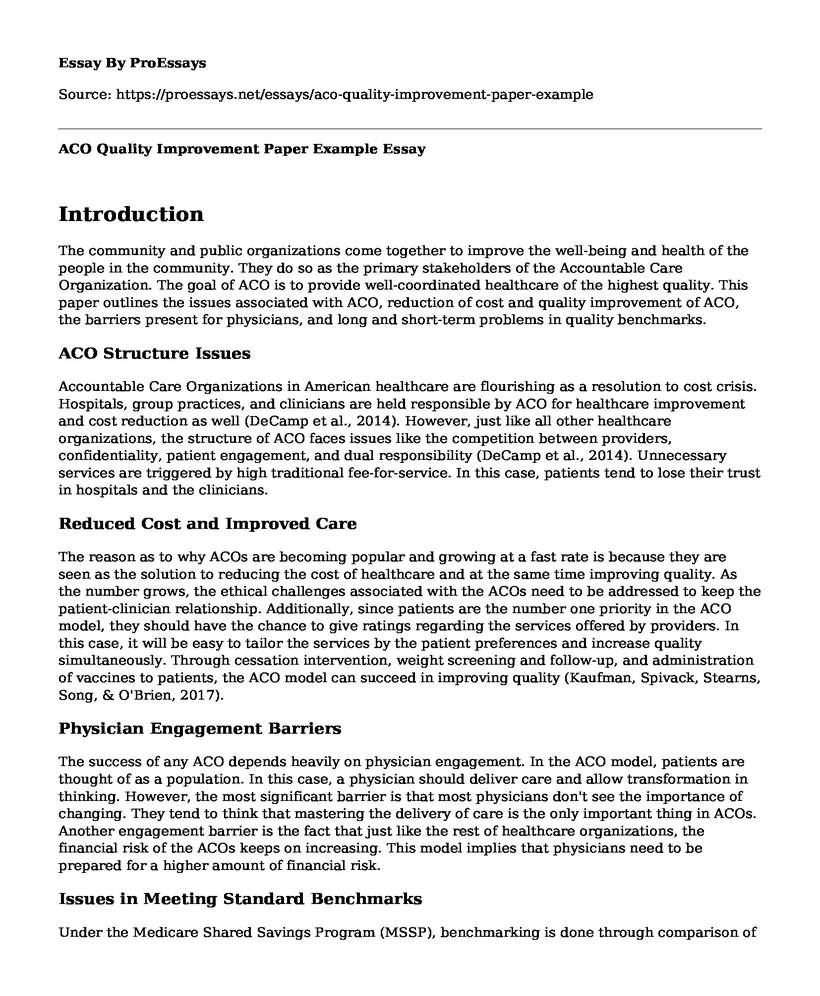Introduction
The community and public organizations come together to improve the well-being and health of the people in the community. They do so as the primary stakeholders of the Accountable Care Organization. The goal of ACO is to provide well-coordinated healthcare of the highest quality. This paper outlines the issues associated with ACO, reduction of cost and quality improvement of ACO, the barriers present for physicians, and long and short-term problems in quality benchmarks.
ACO Structure Issues
Accountable Care Organizations in American healthcare are flourishing as a resolution to cost crisis. Hospitals, group practices, and clinicians are held responsible by ACO for healthcare improvement and cost reduction as well (DeCamp et al., 2014). However, just like all other healthcare organizations, the structure of ACO faces issues like the competition between providers, confidentiality, patient engagement, and dual responsibility (DeCamp et al., 2014). Unnecessary services are triggered by high traditional fee-for-service. In this case, patients tend to lose their trust in hospitals and the clinicians.
Reduced Cost and Improved Care
The reason as to why ACOs are becoming popular and growing at a fast rate is because they are seen as the solution to reducing the cost of healthcare and at the same time improving quality. As the number grows, the ethical challenges associated with the ACOs need to be addressed to keep the patient-clinician relationship. Additionally, since patients are the number one priority in the ACO model, they should have the chance to give ratings regarding the services offered by providers. In this case, it will be easy to tailor the services by the patient preferences and increase quality simultaneously. Through cessation intervention, weight screening and follow-up, and administration of vaccines to patients, the ACO model can succeed in improving quality (Kaufman, Spivack, Stearns, Song, & O'Brien, 2017).
Physician Engagement Barriers
The success of any ACO depends heavily on physician engagement. In the ACO model, patients are thought of as a population. In this case, a physician should deliver care and allow transformation in thinking. However, the most significant barrier is that most physicians don't see the importance of changing. They tend to think that mastering the delivery of care is the only important thing in ACOs. Another engagement barrier is the fact that just like the rest of healthcare organizations, the financial risk of the ACOs keeps on increasing. This model implies that physicians need to be prepared for a higher amount of financial risk.
Issues in Meeting Standard Benchmarks
Under the Medicare Shared Savings Program (MSSP), benchmarking is done through comparison of predetermined value. The value is determined by deriving the average costs of healthcare in an ACO. For an ACO, the benchmark is rebased after every new contract is put in place. What follows is the calculation of the organization's healthcare cost in the past three years which would be used to rebase in the long-term (second term). In the short-term, the ACO has to work towards achieving the set standard of quality and cost for the first term and still work on improving it by 2.0% (Harvey, Gowda, Gazelle, & Pandharipande, 2014). Looking at Luke's perspective, the ACO incentive structure is a more powerful motivator than personal conviction. The model is succeeding in improving quality and reducing cost in the United States, and this is s proper motivation for Luke.
Conclusion
In conclusion, ACOs are an excellent opportunity for clinicians, the community and healthcare providers to come together to deliver high-quality care reducing the coat in the meantime. ACO model issues can be mitigated through the absolute involvement of patients in giving feedback regarding services offered. Additionally, for any physician that wishes to join ACO is discouraged by the high risks which might be harmful financially.
References
DeCamp et al. (2014). Ethical challenges for accountable care organizations: a structured review. Journal of General Gnternal Medicine, 1392-1399.
Harvey, H. B., G. V., Gazelle, G. S., & Pandharipande, P. V. (2014). The ephemeral accountable care organization-an unintended consequence of the Medicare Shared Savings Program. Journal of the American College of Radiology, 121-124.
Kaufman, B. G., Spivack, B. S., Stearns, S. C., Song, P. H., & O'Brien, E. C. (2017). Impact of accountable care organizations on utilization, care, and outcomes: a systematic review. Medical Care Research and Review.
Cite this page
ACO Quality Improvement Paper Example. (2022, Nov 20). Retrieved from https://proessays.net/essays/aco-quality-improvement-paper-example
If you are the original author of this essay and no longer wish to have it published on the ProEssays website, please click below to request its removal:
- Critical Infrastructure Security Emergency Management: An Assessment of Richmond-Virginia International Airport
- Paper Example on Medicine-Origin and Chemical Treatment of Asthma
- Defining Competitiveness, Designing Pay Levels, Mix, and Pay Structures Essay
- Essay Sample on Drug Overdose
- Essay Sample on Pro-Choice Abortion
- Essay Sample on Child Anemia: Causes, Symptoms & Treatment
- Tuberculosis: Global Concern & Its Epidemiology - Essay Sample







